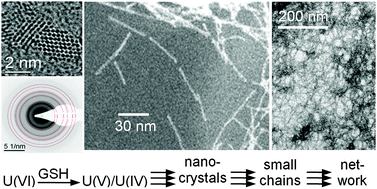Network-like arrangement of mixed-valence uranium oxide nanoparticles after glutathione-induced reduction of uranium(vi)†
Abstract
Glutathione (GSH), a ubiquitous intracellular reducing tripeptide, is able to reduce hexavalent uranium, U(VI), to its tetravalent form, U(IV), in aqueous media in vitro, inducing the formation of nanocrystalline mixed-valence uranium oxide particles. After the initial reduction to U(V) and subsequent dismutation, the yielded U(IV) rapidly hydrolyses under near-neutral conditions forming 2–5 nm sized nanoparticles. The latter further aggregate to 20–40 nm chain-like building blocks that finally arrange as network-like structures.



 Please wait while we load your content...
Please wait while we load your content...